2024 - Crescendo
In CRESCENDO presented by Haas, two competing alliances are invited to score notes, amplify their speaker, harmonize onstage, and take the spotlight before time runs out. Alliances earn additional rewards for meeting specific scoring thresholds and for cooperating with their opponents.


2023 - Charged Up
In CHARGED UPSM presented by Haas, two competing alliances are invited to process game pieces to bring energy to their community. Each alliance brings energy to their community by retrieving their game pieces from substations and scoring it into the grid. Human players provide the game pieces to the robots from the substations. In the final moments of each match, alliance robots race to dock or engage with their charge station!


2022 - Rapid React
In RAPID REACT, presented by The Boeing Company, teams must use innovative engineering, creative thinking, and teamwork to reimagine the future of safe, high-speed travel, and lightning-fast deliveries to propel the next evolution of transportation forward – in this world and beyond. Watch the game animation for a closer look at RAPID REACT and important game details, rules, point-scoring, and game-play options.
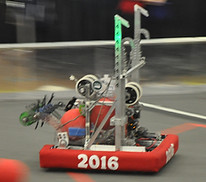

2020-2021 - Infinite Recharge
In INFINITE RECHARGE, two alliances work to protect FIRST City from approaching asteroids caused by a distant space skirmish. Each Alliance, along with their trusty droids, race to collect and score Power Cells in order to energize their Shield Generator for maximum protection. To activate stages of the Shield Generator, droids manipulate their Control Panels after scoring a specific number of Power Cells. Near the end of the match, droids race to their Rendezvous Point to get their Shield Generator operational in order to protect the city! Due to the Covid-19 pandemic in 2021, teams were given at-home challenges.
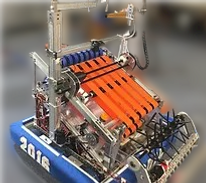

2019 - Deep Space
In DESTINATION: DEEP SPACE, Presented By The Boeing Company, we join two competing ALLIANCES collecting samples on Planet Primus. Unpredictable terrain and weather patterns make remote ROBOT operation essential to their mission on the planet. With only 2:30 until liftoff, the ALLIANCES must gather as many CARGO pods as possible and prepare their spaceships before the next SANDSTORM arrives.


2018- Power Up
FIRST Power Up, stylised as FIRST POWER UP, is the FIRST Robotics Competition game for the 2018 season. It involves two alliances of three teams each, with each team controlling a robot and performing specific tasks on a field to score points. The game has a retro 8-bit theme and teams are required to place milk crates, or "power cubes", on large balancing scales to tip the scale and gain ownership. Alliances can also trade power cubes for power ups, giving them a temporary advantage in a match. At the end of the match, robots can climb the tower attached to the centre balancing scale using a rung attached to the tower, giving them additional points.
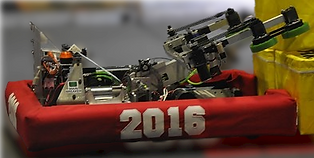.png)

2017 - Steamworks
As in past games, two alliances of three individual teams and their robots compete on a field to score "match" point to win the game and ranking points to advance to playoff rounds. The game has a steampunk theme and teams are required to shoot wiffleballs which represent fuel into a simulated boiler which transfers the generated steam into an airship in the middle of the field. Each alliance has one airship, which they pressurize with steam from the boiler and load with plastic gears from the field. At the end of the match, robots can climb and hang on team-supplied ropes (or standard ropes supplied by FIRST) attached to the airship for additional points


2016 - Stronghold
FIRST Stronghold is played by two alliances of three teams each and involves breaching the opponents' defenses, known as outer works, and capturing their tower by first firing "boulders" (small foam balls) at it and then surrounding or scaling the tower using rungs. Points are scored by crossing elements of the tower's outer works, shooting boulders into the opposing tower's five goals in order to lower the tower's strength, and surrounding and scaling the tower.
The Quest
Robots operate autonomously for the first 15 seconds of the Quest. Alliances score points in this period by reaching opponents' defenses, crossing defenses, and scoring boulders through goals in the opposing tower. Human drivers take control for the final 2 minutes and 15 seconds controlling their robot to defend their castle, retrieve boulders, defeat defenses, score goals from the opponents' courtyard into their tower and capture and scale the opponent's tower.
The Outer Works (outermost line of fortification)
FIRST Stronghold includes eight defensive options. These include the low bar, which is permanent in its place. The rest are chosen by the alliance before each quest and one is periodically chosen by the audience.
The Tower
Openings in the tower are available for robots to score boulders. Scoring boulders reduces a tower's strength as indicated by decreasing tower lights. The tower's flag will drop when enough boulders are scored and then the tower can be captured at the end of the Quest.
The Capture
During the last 20 seconds of the Quest, robots may surround and scale the tower to capture it. When capture is successful, their flag is raised on the opposing tower and even more points are earned.
The Alliance with the highest score at the end of the Quest wins!
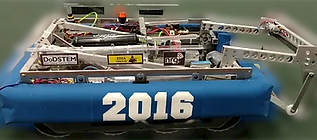
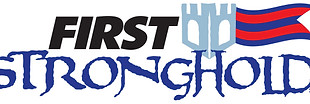
2015 - Recycle Rush
Recycle Rush is a recycling-themed game played by two Alliances of three robots each. Robots score points by stacking totes on scoring platforms, capping those stacks with recycling containers, and properly disposing of pool noodles, representing litter. In keeping with the recycling theme of the game, all game pieces used are reusable or recyclable by teams in their home locations or by FIRST® at the end of the season.
Each Alliance competes on their respective 26 ft. by 27 ft. side of the playing field. Each match begins with a 15-second Autonomous Period in which robots operate independently of their drivers. During this period, robots attempt to earn points by moving themselves, their yellow totes, and their recycling containers into the area between the scoring platforms, called the Auto Zone. During the remaining two minutes and 15 seconds of the match, called the Teleoperated Period, robots are controlled remotely by student drivers located behind the walls at the ends of the field. Teams on an Alliance work together to place as many totes on their white scoring platforms as possible. Alliances earn additional points for recycling containers placed on the scored totes, with containers at greater height earning more points.
Alliances also earn points for disposing of their litter in their Landfill Zone near the center of the field, or placing litter in or on scored recycling containers. Alliances that leave litter unprocessed on their side of the field at the end of the match, not in scoring position, will add points to the score of the other Alliance. Alliances have an opportunity to earn Coopertition® points by coordinating with the other Alliance in the match. Coopertition points are awarded if, at some point in the match, there are at least four yellow totes on the step simultaneously. Coopertition points are doubled if the Alliances arrange at least four of those yellow totes in a single stack on the step.


2014 - Aerial Assist
Aerial Assist is played by two competing Alliances of three robots each on a flat 25 x 54 foot field, straddled by a truss suspended just over five feet above the floor. The objective is to score as many balls in goals as possible during a two (2)-minute and 30-second match. The more Alliances score their ball in their goals, and the more they work together to do it, the more points their Alliance receives.
The match begins with one 10-second Autonomous Period in which robots operate independently of driver. Each robot may begin with a ball and attempt to score it in a goal. Alliances earn bonus points for scoring balls in this mode and for any of their robots that move in to their zones. Additionally, each high/low pair of goals will be designated 'hot' for five seconds, but the order of which side is first is randomized. For each ball scored in a 'hot' goal, the Alliance earns additional bonus points. For the rest of the match, drivers remotely control robots from behind a protective wall. Once all balls in autonomous are scored, only one ball is re-entered in to play, and the Alliances must cycle a single ball as many times as possible for the remainder of the match. With the single ball, they try to maximize their points earned by throwing balls over the truss, catching balls launched over the truss, and scoring in the high and low goals on the far side of the field.
Alliances receive large bonuses for assists, which are earned for each robot that has possession of the ball in a zone as the ball moves down the field. Points are awarded for each action completed.
.png)
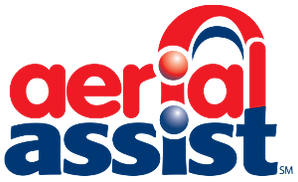
2013 - Ultimate Ascent
Ultimate Ascent is played by two competing alliances on a flat, 27 x 54 foot field. Each Alliance consists of three robots, and they compete to score as many discs into their goals as they can during a two (2)-minute and fifteen (15)-second match. The higher the goal in which the disc is scored, the more points the Alliance receives.
The match begins with a fifteen (15)-second Autonomous Period in which robots operate independently of driver inputs. Discs scored during this period are worth additional points. For the remainder of the match, drivers control robots and try to maximize their alliance score by scoring as many goals as possible.
The match ends with robots attempting to climb up pyramids located near the middle of the field. Each robot earns points based on how high it climbs.


2012 - Rebound Rumble
Rebound Rumble is played by two competing Alliances on a flat, 27 x 54 foot field. Each Alliance consists of three robots. They compete to score as many basketballs into their hoops as they can during a 2 minute and 15 second match. The higher the hoop in which the basketball is scored, the more points the Alliance receives. The match begins with a 15-second Hybrid Period in which robots operate independently of driver inputs.
During this Hybrid Period, one robot on each Alliance may be controlled using a Microsoft Kinect. Baskets scored during this period are worth extra points. For the remainder of the match, drivers control robots and try to maximize their Alliance score by scoring as many baskets as possible. The match ends with robots attempting to balance on bridges located at the middle of the field. In Qualification Matches, a robot from each Alliance will also try to balance on the white Coopertition® bridge to score additional ranking points for each Alliance.


2011 - Logo Motion
Logo Motion is the 2011 FIRST robotics Competition. Field elements are inner tubes shaped like the components of the FIRST robotics logo. The objective of the game is to place them on the racks to gain points. If you create the FIRST logo on the rack you achieve more points. In the end game robots deploy smaller robots or a minibot to climb a tower. Mini bots must be made from FIRST Tech Challenge kit of parts. The 2011 game celebrates the 20th season of the FRC and also commemorates Jack Kamen, who designed the original FIRST® Logo.
.png)
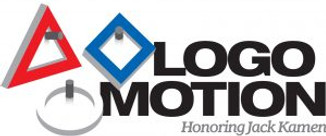
2010 - Breakaway
Robots play Breakaway on a 27 by 54-foot rectangular field known as the field. The field is bordered by a set of guardrails and alliance walls. There are two "bumps" in the field that divide it into three zones. During matches, the robots are controlled from alliance stations located outside the field at both ends. These rectangular zones consist of three-team player stations that provide connectivity between the controls used by the robot operators and the arena. Goals are located at the corners of the field, and extend behind the alliance wall and adjacent to the player stations. After goals are scored, human players must pick up the balls and pass them to the center of the alliance station to be placed on a ball return rack, after which they will re-enter play at midfield. Teams are penalized if balls are not re-entered within a set time limit.
Each round lasts two minutes and fifteen seconds. In the first fifteen seconds of a round, the robots run in autonomous mode, then there are two minutes of game play during which robots are user-controlled. The game is played by two three-robot alliances with each team starting one robot in each of the three sections of the field. At the beginning of a match, every robot must be touching either one of the bisecting bumps or an alliance wall. Also, at the start of the match each of the 12 balls in play must be placed at one vertex of a six foot by six foot gird. There are two grids marked at either ends of each of the three zones.
Balls are kicked or herded into goals located in the corners of the fields. There are two goals for each alliance, adding up to 4 goals total.
2009 - Lunacy
Lunacy is played on a rectangular field that is 54' by 27'. This field is a material called 'Glasliner FRP' and is referred to as 'Regolith'. The regolith is designed so that the robots, which have special mandated wheels that they cannot modify in any way, shape or form, have reduced traction, mimicking the effect of low gravity that would be seen by a robot driving on the moon.
The goal of the game is to score as many of the game pieces in the opposing side's trailers as possible. Robots start out in front of the opposite alliances' human players. There is a 15 second autonomous period, during which robots operate according to programs that teams download to their robot, and a 2 minute Teleported period, where robots are driven and controlled by a human drive subteam at one end of the field. Empty cells (also worth 2 points) must be handed to a robot by the "payload specialist" at the mid-field position known as the "outpost". The robot must deliver the Empty Cell to their human player on one of the corners in order to get a Super Cell that is worth 15 points. A robot can only carry one Empty Cell at a time. Super Cells can only be put into play during the last 20 seconds of play, and only if the human player has been delivered an Empty Cell.
Moon Rocks (Orange and Purple) — 120 available — 2 pts each
Empty Cells (Orange and Blue) — Up to 8 — 2 pts each
Super Cells (Green and Purple) — Up to 8 — 15 pts each
Total score for the alliance is the total number of points scored by placing Moon Rocks, Empty
Cells and Super Cells in the trailers of all of the robots of the opposing alliance, less any deductions for penalties.

2008 - Overdrive
First Overdrive was the 2008 for the FIRST Robotics competition, Announced on January 5, 2008 Teams competed to complete a counter clockwise lap around a central barrier while manipulating large 40 inch diameter trackballs over and under overpasses to score additional point. FIRST Overdrive is played on a 54 ft (16 m) by 27 ft (8 m) carpeted field, divided lengthwise by a fence median to create a track, and separate the field into Red and Blue zones. The fence is crossed by an overpass marking the red and blue finish three-team alliances race around the track in a counter clockwise direction while manipulating the trackballs to score points. The game is made up of two scoring periods. The FIRST 15 seconds of play is the Hybrid period in which robots are autonomous, and may also respond to certain digital signals sent by team members designated as "Robocoaches", who are stationed at the corners of the track. The next two minutes of play is the Tele-operated period. At this time, robots are fully radio controlled by the team operators standing at either end of the field.
2007 - Rack 'N' Roll
Each match of Rack 'n Roll is 2 minutes 15 seconds long, divided into three segments. The first segment is a 15 second autonomous period, where robots may attempt to place keepers onto the rack without human input. Once autonomous mode is complete, any keepers not already on the rack are no longer valid for scoring. The second segment, the tele-operated mode, is 2 minutes long, during which robots are operated by the drivers and may roam anywhere on the field. In the final 15 seconds, the end game, robots may not enter their opponent's end zone, but all other rules remain the same from the tele-operated period. Though the head referee may pause the game between the autonomous period and the tele-operated period, the end game follows directly after the tele-operated period.
The Rack 'n Roll field is dominated by 'The Rack', a large metal contraption with three levels of hanging metal bars, with each level having 8 arms evenly spaced in an octagon. Each arm (known as a 'spider leg') has space for two game pieces. Any more pieces placed on a spider leg beyond the first two are ignored for scoring purposes. At the beginning of the match, the rack is arbitrarily translated or rotated within three of the center of the field in order to give some randomness and to encourage autonomous modes that do not depend on dead-reckoning. At the top of the Rack are four green-colored lights above the 1, 3, 5, and 7 legs to aid in autonomous-mode tracking.
.png)





.png)




